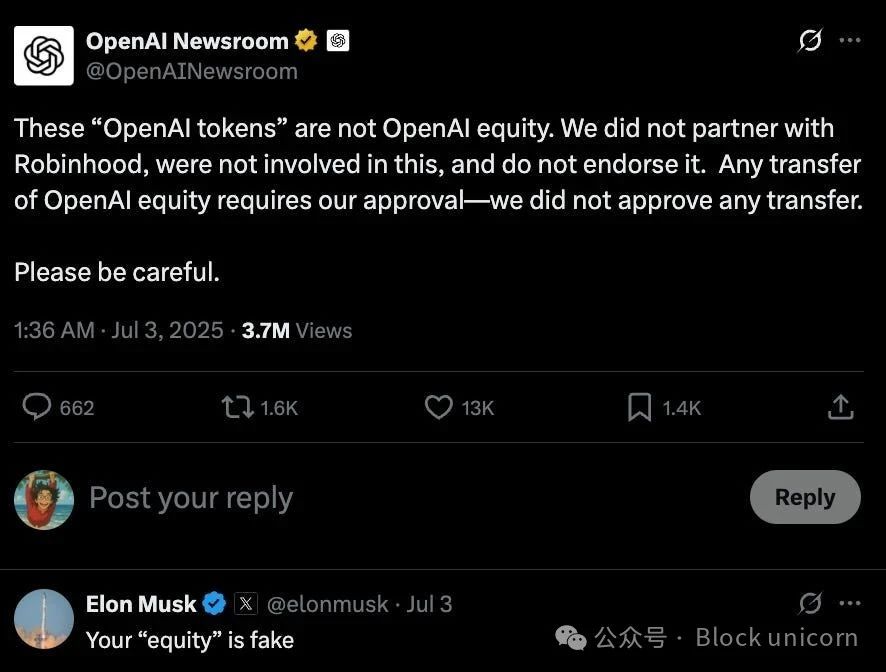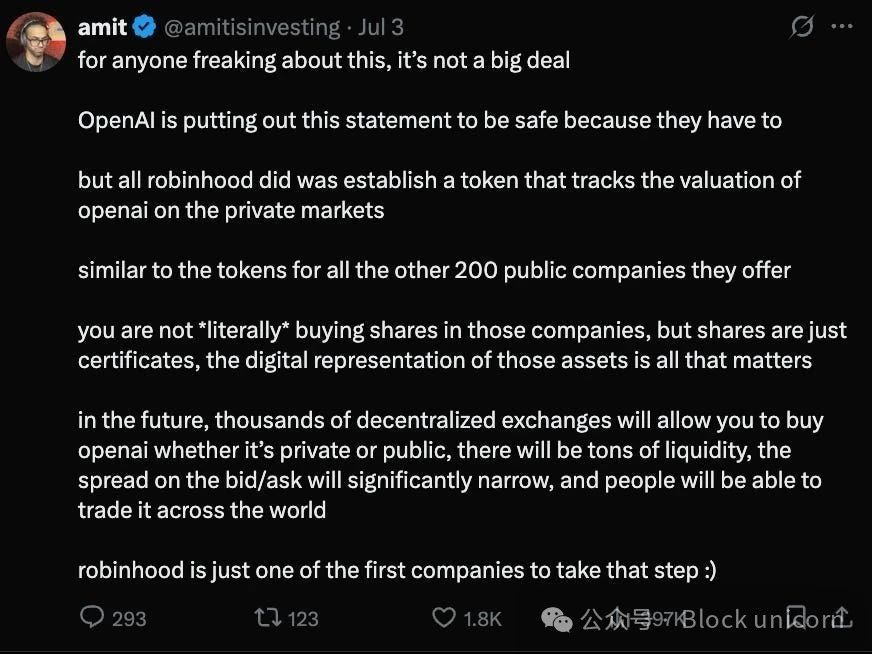编译:Block unicorn
前言
在 1980 年代末,内森·莫斯特(Nathan Most)在美国证券交易所工作。不过,他不是银行家也不是交易员。他是一位物理学家,曾在物流行业工作多年,负责运输金属和商品。金融工具并不是他的起点,实用系统才是。
当时,共同基金是一种获得广泛市场敞口的热门方式。它们为投资者提供了多样化,但也有延迟。你无法在交易日中随时买卖。你下了订单,然后等到市场收盘才能知道成交价格(顺便说一句,它们至今仍以这种方式交易)。这种体验感觉过时,尤其是对于那些习惯于实时买卖个股的人来说。
内森提出了一个变通方案:创建一个追踪标普 500 指数但像单只股票一样交易的产品。将整个指数打包成一种新形式,然后在交易所上市。该提议遭到了质疑。共同基金的设计初衷并非像股票那样买卖。相关的法律框架当时并不存在,市场似乎也不需要它。
他还是继续推进了。
代币化股票
1993 年,标普存托凭证(SPDR)以 SPY 的代码首次亮相。这本质上是第一只交易所交易基金(ETF)。一种代表数百只股票的工具。最初被视为一个小众产品,它逐渐成为全球交易量最大的证券之一。在许多交易日,SPY 的交易量超过它所跟踪的股票。一个合成结构获得了比其基础资产更高的流动性。
今天,这个故事再次显得重要。不是因为又一只基金的推出,而是因为链上发生的事情。
Robinhood、Backed Finance、Dinari 以及像 Republic 这样的投资平台开始提供代币化股票——基于区块链的资产,旨在反映特斯拉、英伟达,甚至 OpenAI 等私营公司的价格。
这些代币被宣传为一种获得敞口而非所有权的方式。没有股东地位,也没有投票权。你并不是传统意义上的购买股权。你持有的是与股权相关的代币。
这一区别很重要,因为这已经引发了争议。
OpenAI 甚至埃隆·马斯克都对 Robinhood 提供的代币化股票表示了担忧。

Robinhood 首席执行官特内夫随后不得不澄清,这些代币实际上让散户投资者接触到了这些私人资产。
与公司本身发行的传统股票不同,这些代币是由第三方创建的。有些声称持有真实股票作为托管,提供 1:1 的背书。其他则是完全合成的。体验感觉熟悉:价格像股票一样波动,界面类似于经纪商应用,尽管其背后的法律和财务实质往往较薄弱。
尽管如此,它们仍然吸引着特定类型的投资者。尤其是那些在美国以外的投资者,他们无法直接投资美国股票。如果你住在拉各斯、马尼拉或孟买,并且想要投资英伟达,通常需要一个外国经纪账户、较高的最低余额和较长的结算周期。
而链上交易的代币则追踪基础股票在交易所的步伐。代币化股票省去了交易过程中的摩擦。想想看,没有电汇,没有表格,没有门槛。只需一个钱包和一个市场。
这种访问方式感觉新颖,尽管其机制类似于更古老的东西。
但这里有一个实际问题。许多这类平台——Robinhood、Kraken 和 Dinari——在美国以外的许多新兴经济体中无法运营。例如,目前尚不清楚一个印度用户能否通过这些途径合法或实际购买代币化股票。
如果代币化股票要真正扩大全球市场的准入,摩擦不仅是技术上的,还将是监管、地理和基础设施方面的。
衍生品的运作方式
期货合约长期以来提供了一种在不触及基础资产的情况下进行交易的方式。期权让投资者表达对波动性、时机或方向的看法,通常无需购买股票本身。在每种情况下,期权产品都成为投资标的资产的另一种途径。
代币化股票的出现也带着类似的意图。它们并不声称比股票市场更好。它们只是提供了另一种投资途径,特别是对于那些长期被排除在公共投资边缘的人来说。
新的衍生品通常遵循一个可识别的轨迹。
起初,市场一片混乱。投资者不知如何定价,交易员对风险犹豫不决,监管机构则退后观察。随后,投机者蜂拥而至。他们试探底线,拓展产品范围,并利用低效套利。随着时间的推移,如果产品被证明有效,就会被更多主流参与者采用。最终,它成为基础设施。
这就是指数期货、ETF,甚至 CME 和 Binance 上的比特币衍生品的发展历程。它们一开始并不是为所有人设计的工具。它们始于投机的游乐场:更快、风险更高,但更灵活。
代币化股票可能遵循相同的路径。最初由散户交易者使用,追逐难以触及的资产敞口,如 OpenAI 或 IPO 前的公司。然后被套利者采用,利用代币与其基础股票之间的价格差。如果交易量持续增长,基础设施成熟,机构投资者也可能开始使用它们,特别是在合规框架出现的司法管辖区。
早期活动可能看起来嘈杂,流动性不足,点差较大,周末价格缺口明显。但衍生品市场往往是这样起步的。它们绝不是完美的复制品。它们是压力测试。是市场在资产本身调整之前发现需求的方式。
这种结构有一个有趣的特点或缺陷,取决于你如何看待它。
时间差。
传统股票市场有开盘和收盘时间。即使是基于股票的大多数衍生品也在市场时间交易。但代币化股票并不总是遵循这些节奏。如果一只美国股票在周五收盘时价格为 130 美元,而周六发生了重大事件——比如财报泄露或地缘政治事件——代币可能开始对此作出反应,尽管股票本身是静止的。
这使得投资者和交易者能够将股票市场关闭时传来的消息考虑在内。
只有在代币化股票的交易量显著大于股票本身的情况下,时间差才会成为问题。
期货市场通过资金费率和保证金调整来应对这种挑战。ETF 依靠授权参与者和套利机制来保持价格一致。到目前为止,代币化股票至少还没有这些系统。价格可能出现波动。流动性可能不足。代币与其参考资产之间的联系仍然依赖于对发行人的信任。
然而,这种信任程度各不相同。当 Robinhood 在欧盟推出 OpenAI 和 SpaceX 的代币化股票时,两家公司均否认有任何参与。没有协调,也没有正式关系。
这并不是说代币化股票本身有问题。但值得问的是,在这些情况下你买的是什么?是对价格的敞口,还是权利和追索权不明的合成衍生品?

这些产品背后的基础设施也有很大差异。有些在欧洲框架下发行。其他依赖智能合约和离岸托管机构。少数平台,如 Dinari,正在尝试更受监管的方式。大多数仍在测试法律可能的界限。
在美国,证券监管机构尚未明确表态。美国证券交易委员会(SEC)对代币销售和数字资产的态度已明确,但代币化传统股票的表示仍属灰色地带。平台保持谨慎。例如,Robinhood 选择在欧盟而非其本土市场推出其产品。
即便如此,需求是显而易见的。
Republic 已为 SpaceX 等私营公司提供了合成通道。Backed Finance 包装公开股票并在 Solana 上发行。这些尝试尚处于起步阶段,但却在持续进行,并且其背后的支撑模式承诺解决摩擦而非融资问题。代币化股票发行可能无法改善所有权的经济性,因为这不是他们想要实现的目标。他们只是想简化参与体验。或许如此。
而对散户投资者来说,参与往往是最重要的。
从这个意义上讲,代币化股票并非与股票竞争,而是与获取股票所需的努力竞争。如果投资者只需轻点几下,就能通过一款同时持有其稳定币的应用程序,获得对英伟达的定向投资,他们可能并不在乎该产品是否是合成的。
不过,这种偏好并非新鲜事。SPY 的研究表明,包装产品可以成为主要市场。差价合约(CFDs)、期货、期权和其他衍生品也是如此,它们最初是交易员的工具,但最终服务于更广泛的受众。
这些衍生品往往甚至领先于基础资产。同时,它们吸收了市场情绪,比下方较慢的市场更快地反映恐惧或贪婪。
代币化股票可能遵循相似的路径。
基础设施尚处于起步阶段。流动性不均衡。监管缺乏透明度。但其潜在的动力是显而易见的:构建一个能够反映资产、更易于访问且足够好地供人们参与的体系。如果这种表征能够保持其形态,那么更多的交易量将会流经它。最终,它将不再是影子,而成为一种信号。
内森·莫斯特 (Nathan Most) 的初衷并非重新定义股票市场。他看到了低效之处,并寻求更流畅的界面。如今的代币发行者也在做同样的事情。只是这一次,包装器是智能合约,而不是基金结构。
值得关注的是,这些新包装能否在市场变得艰难时站稳脚跟。
它们不是股票。它们不是受监管的产品。它们是接近的工具。对于许多用户,特别是那些远离传统金融或身处遥远地区的人来说,这种接近可能就足够了。
免责声明:本文章仅代表作者个人观点,不代表本平台的立场和观点。本文章仅供信息分享,不构成对任何人的任何投资建议。用户与作者之间的任何争议,与本平台无关。如网页中刊载的文章或图片涉及侵权,请提供相关的权利证明和身份证明发送邮件到support@aicoin.com,本平台相关工作人员将会进行核查。




